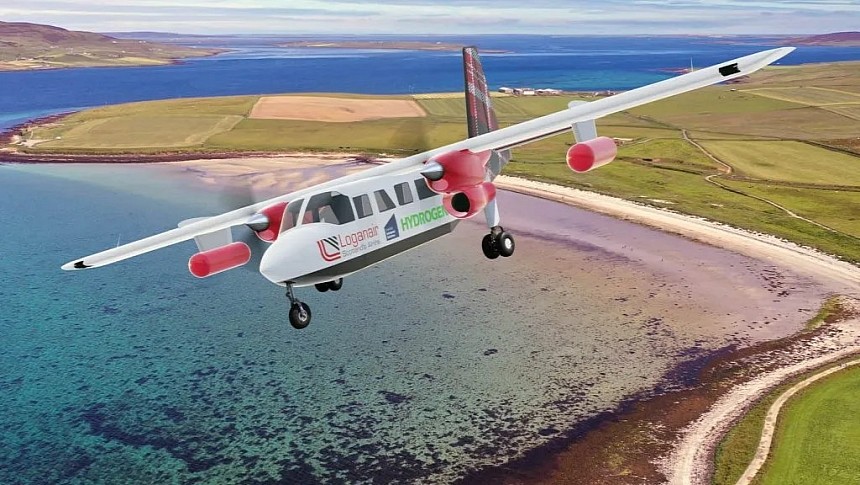On its path to net zero operations, the UK's largest regional airline is taking the necessary steps for what might be the first zero-emission passenger service in the country. To do so, Loganair will operate Britten-Norman Islander aircraft that were retrofitted with the hydrogen propulsion solution developed by Cranfield Aerospace.
Hydrogen-electric aircraft are set to kick off commercial service in Kirkwall, the biggest town in Orkney, which is an archipelago located to the north of mainland Scotland, in just three years from now. These won't be new-generation airliners but retrofitted Islanders from Loganair's fleet.
The aviation operator has signed a MoU with Cranfield Aerospace that will enable them to develop an eco-system for upcoming hydrogen-electric flights based on Cranfield's hydrogen fuel cell (HFC) propulsion solution. Orkney is particularly appealing for testing this new technology because of its harsher weather conditions and because the typical flights operated by Logainair in this area are short-haul routes.
With this collaboration, Orkney is set to become the first official location for the retrofitted Islander's commercial flights. The hydrogen-electric version is expected to secure certification in 2026 and kick off regular passenger flights in the region by 2027.
The conversion of a conventional nine-seat Britten-Norman Islander to HFC propulsion is the object of Cranfield's Project Fresson, partly funded by the Aerospace Technology Institute. The hydrogen-powered Islander aims to become the first fully certified green passenger aircraft of its kind. The retrofitted version boasts a six-to-eight-seat capacity, a range of up to 400 km (248.5 miles), and a 60-minute endurance (plus a 45-minute reserve). It also claims to lower operational costs by 45% compared to the standard version.
The B-N Islander conversion is only the first step toward hydrogen-powered commercial flights. Once the certified Islander enters commercial service, Cranfield Aerospace will focus on adapting its HFC technology to various platforms that require a bigger output. Starting in 2030, the focus will shift toward brand-new aircraft designs developed around the HFC technology. These will be the green airliners of the future that combine HFC powertrains of 1 MW with a 19-seat capacity.
Last year, Cranfield Aerospace also launched a collaboration with an Australian charter operator and a leasing company, which will introduce hydrogen-powered flights to Australia. ZeroAvia is another aviation innovator that is developing hydrogen powertrains for commercial aircraft and following a similar path of retrofitting existing aircraft before adapting its technology to newly designed airliners.
Aviation is notoriously difficult to decarbonize, which is why retrofitting standard aircraft with HFC technology can be an efficient way to speed things up before new-generation models can replace current commercial fleets entirely.
Loganair intends to start operating its first hydrogen-electric Islander in Kirkwall in 2027 as a first step toward zero-emission operations.
The aviation operator has signed a MoU with Cranfield Aerospace that will enable them to develop an eco-system for upcoming hydrogen-electric flights based on Cranfield's hydrogen fuel cell (HFC) propulsion solution. Orkney is particularly appealing for testing this new technology because of its harsher weather conditions and because the typical flights operated by Logainair in this area are short-haul routes.
With this collaboration, Orkney is set to become the first official location for the retrofitted Islander's commercial flights. The hydrogen-electric version is expected to secure certification in 2026 and kick off regular passenger flights in the region by 2027.
The conversion of a conventional nine-seat Britten-Norman Islander to HFC propulsion is the object of Cranfield's Project Fresson, partly funded by the Aerospace Technology Institute. The hydrogen-powered Islander aims to become the first fully certified green passenger aircraft of its kind. The retrofitted version boasts a six-to-eight-seat capacity, a range of up to 400 km (248.5 miles), and a 60-minute endurance (plus a 45-minute reserve). It also claims to lower operational costs by 45% compared to the standard version.
The B-N Islander conversion is only the first step toward hydrogen-powered commercial flights. Once the certified Islander enters commercial service, Cranfield Aerospace will focus on adapting its HFC technology to various platforms that require a bigger output. Starting in 2030, the focus will shift toward brand-new aircraft designs developed around the HFC technology. These will be the green airliners of the future that combine HFC powertrains of 1 MW with a 19-seat capacity.
Last year, Cranfield Aerospace also launched a collaboration with an Australian charter operator and a leasing company, which will introduce hydrogen-powered flights to Australia. ZeroAvia is another aviation innovator that is developing hydrogen powertrains for commercial aircraft and following a similar path of retrofitting existing aircraft before adapting its technology to newly designed airliners.
Aviation is notoriously difficult to decarbonize, which is why retrofitting standard aircraft with HFC technology can be an efficient way to speed things up before new-generation models can replace current commercial fleets entirely.
Loganair intends to start operating its first hydrogen-electric Islander in Kirkwall in 2027 as a first step toward zero-emission operations.









